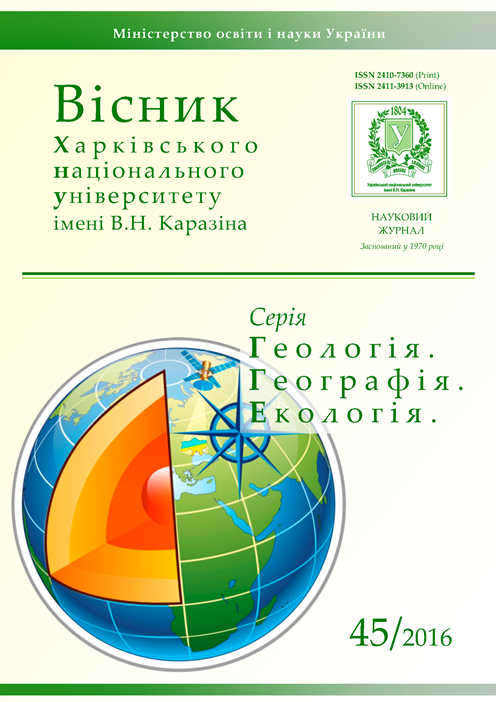Geological factors in the formation conditions of traps in the Orchyk depression perm deposits of Dnieper-Donets basin
Abstract
A variety of screens has been examined theoretically, their screening and limiting functions in hydrocarbon traps formation have been demonstrated. Among their variety as main ones we regard covering and bottom fluid-proof rocks, disjunctives, salt-bodies, hydrodynamic pressure, etc. Place of screens development and their crucial (screening) and secondary (limiting) functions in trap generation were observed. Screen role in deposits and oil and gas field trap forming of Orchik depression uplifts (Upper Carboniferous and Lower Permian rocks apart) were specified. Significant difference in trap types of the series was demonstrated. Leaving out singular exclusion, non-arch lithologic, disjunctive and salt-dome screened and limited traps are most typical for Lower Permian rocks, while Carboniferous traps are mostly screened and limited quasiarch.
The research results, based on virtual data of field studies in detal, are evidence of all the types of screens in the research territory’s wide spreading. Their trap generating and trap limiting role makes it possible to define traps and fields type. Essential part of traps is non-arch.
Variety of traps are caused by screens of different types which act as separate factors, could form complex with others and can be reliable basis for prognosis of similar conditions. Such conditions can exist not only on uplifts but also on monoclines, near-salt-stocks zones and synclines.
Downloads
References
2. Vysochans'ky, I. V. (2015). Naukovi zasady poshukiv nesklepinnykh pastok vuhlevodniv u Dniprovs'ko-Donbas'komu avlakoheni [Scientific research foundations not vaulted hydrocarbon traps in the Dnipro-Donbass hollow]. V. N. Karazin KhNU, 235.
3. Vysochans'kyy, I. V (2014). Morfo-henetychna klasyfikatsiya struktur yak osnova dlya vyyavlennya rezervu novykh pastok VV u Dniprovs'ko-Donbas'komu avlakoheni [Morpho-genetic classification structures as a basis to identify new reserve explosive traps in the Dnipro-Donbass avlakogene]. The issue of Ukraine's gas industry, 2, 10-24.
4. Galickij, I. V. (1963). Nekotorye osobennosti stroenija i istorii razvitija soljanokupol'nyh struktur jugo-vostochnoj chasti DDV [Some features of the structure and history of the salt domes made structures of the south-eastern part of the DDD]. Geological journal, 3, 47-61.
5. Kogan, V. D. (1983). Vozrast diapirovyh struktur vostochnoj chasti Pridneprovskogo grabena [Age diapir struc-tures eastern Dnieper graben]. Oil and Gas Geology, 4, 47-61.
6. Lagutin, A. A., Lizanec, A. V., Muharinskaja, I. A. (1980). Osobennosti porod-kollektorov nizhnepermskoj hemogen-noj tolshhi Melihovskogo gazokondensatnogo mestorozhdenija [Features Lower Permian reservoir rocks chemo-genic column Melikhovo gas condensate field]. The development of the gas industry of the Dnieper-Donets basin and adjacent territories, Moscow, 19-34.
7. Rjabyh, O. F., Prijmenko, A. F. (1984). Karbonatnye kollektory permskoj galogennoj tolshhi DDV [Carbonate res-ervoirs of Permian strata halogen DDD]. Oil and gas industry, 3, 3-6.
8. Gerasimovich, R. V. (1985). Neftegazonosnost' nizhnepermskih otlozhenij jugo-vostoka DDV [Oil and gas deposits of Lower Permian southeast DDD]. Oil and gas industry, 2, 19-21.
9. Boboshko, A. V. Ul'janov, M.G., Shehtman, L. I., Jakovlev, O. Je. (1985). Promyshlennaja gazonosnost' karbonatno-galogennoj tolshhi nizhnej permi jugo-vostochnoj chasti Dneprovsko-Doneckoj vpadiny [Industrial gas-bearing carbonate-Lower Permian strata halogen south-eastern part of the Dnieper-Donets Basin]. Moscow, 50.
10. Kolomiec, Ja. I, Sterlin, B. P., Jakovlev, O. Je. (1984). Promyshlennaja gazonosnost' nizhnepermskih shlejfov jugo-vostochnoj chasti DDV. [Industrial gas-bearing Lower Permian loops south-eastern part of the DDV]. Oil & Gas Industry, 3, 1-3.
11. Kolomiec, Ja. I., Sterlin, B. P., Jakovlev, O. J (1984). Novyj tip gazovyh zalezhej jugo-vostoka Dneprovsko-Doneckoj vpadiny [A new type of gas fields south-east of the Dnieper-Donets Basin]. Geology of oil and gas, 8, 6-9.
12. Tereshhenko, V. A., Jakovlev, O. Je. (1983). Gazogidrodinamicheskie osobennosti nizhnepermskogo hemogennogo kompleksa jugo-vostochnoj chasti Dneprovsko-Doneckoj vpadiny [Gas-hydrodynamic features of the Lower Permian complex chemogenic south-eastern part of the Dnieper-Donets Basin]. Petroleum geology and geophysics, 6,
3-4.
13. Samchuk I. M. (2016). Prohnozuvannya dilyanok rozpovsyudzhennya shleyfiv solyanykh shtokiv [Prediction distri-bution sites loops salt stocks Materials of the All-Ukrainian scientific-practical conference with international participation, 127-129.
14. Arsirij, Yu. O., Babij, B. A., Bilyk, S. F. et al. (1998). Atlas rodovyshch nafty i hazu Ukrajiny [Atlas oil and gas de-posits of Ukraine]. Lviv, UNHA, 3, 932-1416.
15. Vysochanskij, I. V., Dem'janchuk, V. G., Nedzel'skij, D. E., Palij, A.M. (1981). Kachestvennaja harakteristika lovushek [Qualitative characteristics of traps] Petroleum geology and geophysics, 2, 2-6.





